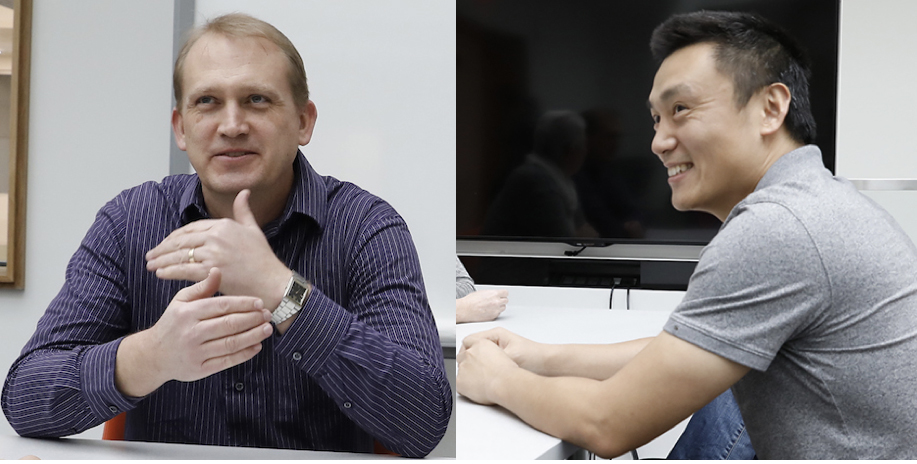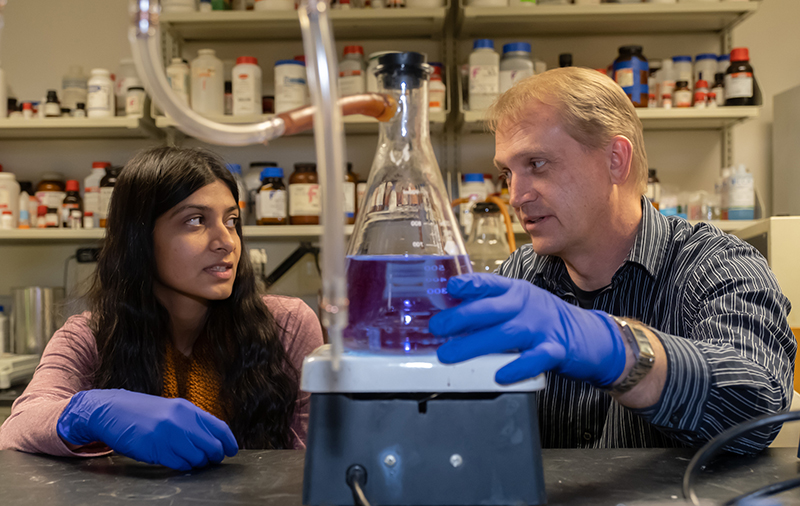
Microbes, QAs, methane: Top to bottom
Recent grants support D.J. Ferguson's and Xin Wang's research on the hidden life of microbes
By Susan Meikle, university news and communications. Part two of a four-part series on new grants for the new microbiology physiology cluster.
Ferguson and Wang: $343,030 NSF RUI grant to study microorganisms that produce methane from different environments

D.J. Ferguson, associate professor of microbiology and of biological sciences at Miami Regionals, and Xin Wang, assistant professor of microbiology
Microbiologists D.J. Ferguson and Xin Wang recently received a $343,030 Research in Undergraduate Institutions (RUI) grant from the National Science Foundation (NSF) to study microbes that produce methane from different environments.
Methane, the key component of natural gas and a potent greenhouse gas, plays an important role in global carbon cycling and atmospheric processes. Some methane-producing microbes (methanogens) have recently been shown to convert a group of compounds called quaternary amines (QAs) to methane, according to Ferguson.
QAs are naturally occurring compounds found particularly in brackish (mixture of saltwater and freshwater) and marine environments. They have not been considered to be a major direct source for biological methane release into the atmosphere, according to Ferguson.
One goal of his research is to determine the mechanisms of how methanogens feed on QAs to produce methane.
Combined with knowledge of these mechanisms, a technique known as metagenomic sequencing will allow Ferguson and Wang to identify particular methanogens that may be using QAs as a food source.
Metagenomic sequencing: opening new doors
Metagenomic sequencing is the study of genetic material recovered directly from environmental samples, such as soil or water. It can reveal previously unknown or un-culturable microbes. The ability to identify microbes without prior knowledge of what a sample contains is opening new doors in disciplines like virology, microbiology and biomedical research.
Ferguson and Wang have already determined the mechanism employed by a particular methanogen — Methanolobus vulcani B1d — for using a QA as a food source. It was isolated from a brackish water sample from the East coast, in Virginia.
They have obtained similar samples from the West coast, in Oregon. They will perform metagenomic sequencing and determine if methanogens from these samples use the same QA-feeding mechanisms as Methanolobus vulcani B1d.
Their long-term goals are:
- To determine how widespread QA-degrading methanogens are.
- To provide supporting evidence to improve computer-generated models that predict the role of methanogenesis on Earth’s atmosphere.
Wang, who joined Miami last year after completing a post-doctoral fellowship at Texas A&M University, is an expert at microbial engineering. With new state-of-the-art equipment in his lab, he can investigate protein development and cell metabolism of the unknown methanogens in the samples.
Ferguson and research group: $366,931 NIH grant to investigate gut microbes
The group is investigating an alternative pathway that some human intestinal microbes follow that may prevent the formation of trimethylamine (TMA), a trigger for heart disease.
There is strong evidence that some microbes in the human gut degrade the QAs found in the diet into TMA, which is a contributor to cardiovascular diseases, according to Ferguson.

Ferguson and doctoral student Jyoti Kashyap (photos by Scott Kissell).
This project investigates an alternative pathway that some human intestinal microbes follow to degrade the QAs by demethylation, preventing the formation of TMA.
The goal of this research is to isolate the gut microbes that follow the route that does not produce TMA.
Using human fecal samples from healthy volunteers, Ferguson and his research group culture the samples in the lab.
The genomes of organisms identified in the samples are studied in detail to identify and characterize the proteins that play a role in the alternative pathway.
- By identifying the proteins in the gut that demethylate QAs, TMA levels can be kept in check in patients suffering from or susceptible to cardiovascular diseases.
- “We're interested in what organisms have this, how prevalent they are in the gut, and how we might see differences among people,” Ferguson said. “That might explain why some people are more susceptible to heart disease than others.”
Ferguson’s collaborators on this project are Joseph Krzycki, professor of microbiology at Ohio State University, and Kelly Wrighton, assistant professor of soil microbiomes at Colorado State University.
Ferguson’s doctoral students are part of the gut microbe research team:
- Adam Creighbaum
- Jyoti Kashyap. She received the 2018 Susan W. Rockwood Award from the microbiology department in recognition of “Excellence in Teaching and Research by a Woman in Graduate Study."
Three undergraduate researchers currently work with Ferguson:
- Aidan Das, sophomore biology major and environmental science co-major.
- Sarah Soppe, senior microbiology and Spanish double major.
- Marie Claire (Claire) Papamarcos, senior microbiology major and environmental science co-major. She was a Miami-Hughes intern with Ferguson last summer.
